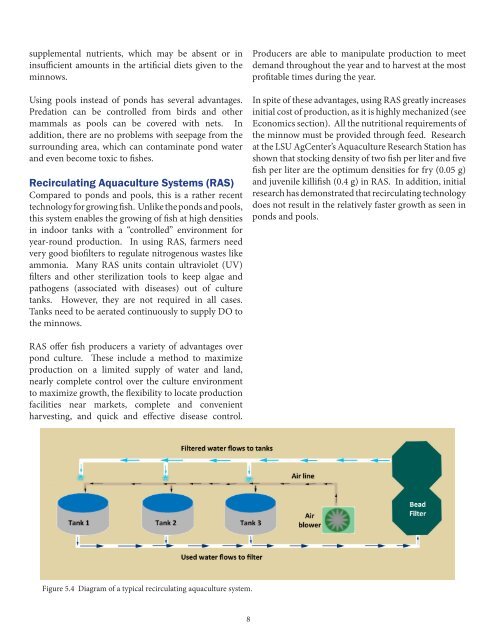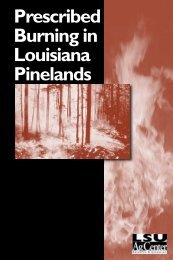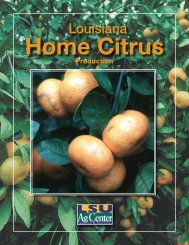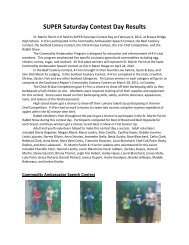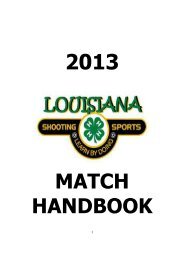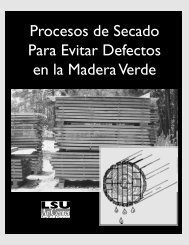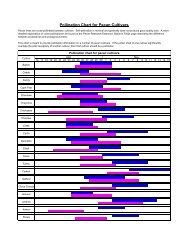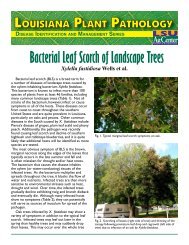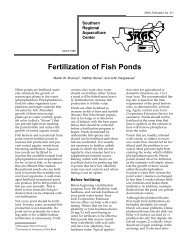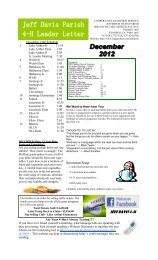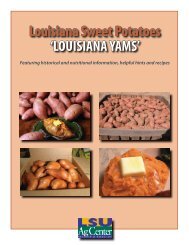Cocahoe Minnow - The LSU AgCenter
Cocahoe Minnow - The LSU AgCenter
Cocahoe Minnow - The LSU AgCenter
You also want an ePaper? Increase the reach of your titles
YUMPU automatically turns print PDFs into web optimized ePapers that Google loves.
supplemental nutrients, which may be absent or in<br />
insufficient amounts in the artificial diets given to the<br />
minnows.<br />
Using pools instead of ponds has several advantages.<br />
Predation can be controlled from birds and other<br />
mammals as pools can be covered with nets. In<br />
addition, there are no problems with seepage from the<br />
surrounding area, which can contaminate pond water<br />
and even become toxic to fishes.<br />
Recirculating Aquaculture Systems (RAS)<br />
Compared to ponds and pools, this is a rather recent<br />
technology for growing fish. Unlike the ponds and pools,<br />
this system enables the growing of fish at high densities<br />
in indoor tanks with a “controlled” environment for<br />
year-round production. In using RAS, farmers need<br />
very good biofilters to regulate nitrogenous wastes like<br />
ammonia. Many RAS units contain ultraviolet (UV)<br />
filters and other sterilization tools to keep algae and<br />
pathogens (associated with diseases) out of culture<br />
tanks. However, they are not required in all cases.<br />
Tanks need to be aerated continuously to supply DO to<br />
the minnows.<br />
RAS offer fish producers a variety of advantages over<br />
pond culture. <strong>The</strong>se include a method to maximize<br />
production on a limited supply of water and land,<br />
nearly complete control over the culture environment<br />
to maximize growth, the flexibility to locate production<br />
facilities near markets, complete and convenient<br />
harvesting, and quick and effective disease control.<br />
Figure 5.4 Diagram of a typical recirculating aquaculture system.<br />
8<br />
Producers are able to manipulate production to meet<br />
demand throughout the year and to harvest at the most<br />
profitable times during the year.<br />
In spite of these advantages, using RAS greatly increases<br />
initial cost of production, as it is highly mechanized (see<br />
Economics section). All the nutritional requirements of<br />
the minnow must be provided through feed. Research<br />
at the <strong>LSU</strong> <strong>AgCenter</strong>’s Aquaculture Research Station has<br />
shown that stocking density of two fish per liter and five<br />
fish per liter are the optimum densities for fry (0.05 g)<br />
and juvenile killifish (0.4 g) in RAS. In addition, initial<br />
research has demonstrated that recirculating technology<br />
does not result in the relatively faster growth as seen in<br />
ponds and pools.


